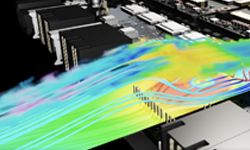 With this release, use cases such as heat sinks, data center cooling, aerodynamics and deformation of solids in linear elastic regime can be solved.
With this release, use cases such as heat sinks, data center cooling, aerodynamics and deformation of solids in linear elastic regime can be solved. 
NVIDIA recently announced the release of SimNet v20.12 with support for new physics such as Fluid Mechanics, Linear Elasticity and Conductive as well as Convective Heat Transfer. Systems governed by Ordinary Differential Equations (ODEs) as well as Partial Differential Equations (PDEs) can now be solved. With this release, use cases such as heat sinks, data center cooling, aerodynamics and deformation of solids in linear elastic regime can be solved.
Previously announced in Sep, NVIDIA SimNet is a Physics Informed Neural Networks (PINNs) toolkit for students and researchers who are either looking to get started with AI-driven physics simulations or are looking to leverage a powerful framework to implement their domain knowledge to solve complex nonlinear physics problems with real-world applications.
SimNet v20.12 highlights
Multi-parameter training of Complex Geometries and Physics:
As a result of enhancements in network architectures as well as performance improvements, SimNet v20.12 converges to a lower loss faster. This enables training on several parameters in a single run. For a 10-parameter Limerock, training and inference for 59,049 configurations (3 values for each design parameter) took 1000 V100 GPU hours. For same number of solver runs, the solver would take over 18.4 million hours (with 26 hours/configuration for a 12-core workstation)

Linear Elasticity in Solids:
Linear elastic solid deformation is now included in the release in both Navier-Cauchy as well as Equilibrium forms. The solution has good agreement with finite element results.
The stresses from the linear elasticity formulation from SimNet were used in a digital twin model, developed by University of Central Florida, using RNN to model fatigue crack growth in an aircraft panel.

Improved STL geometry library:
The PySDF library for STL geometries has been enhanced for about 10x more performance with better accuracy for complex geometries.

Integral form of Partial Differential Equations:
Some physics problems have no classical PDE (or strong) form but only a variational (or weak) form. This requires handling the PDEs in a different approach other than its original (classical) form, especially for interface problem, concave domain, singular problem, etc. In SimNet, the PDEs can be solved not only in their strong form, but also in their weak form.

For example, a point source represented by delta Dirac function cannot be solved by the differential equations based PINNs but an integral form can capture the singular behavior at the center.

Strong Scaling Performance:
For the multi-GPU cases, the learning rate is gradually increased from the baseline case and this allows the model to train without diverging early on and allows the model to converge faster as a result of the increased global batch size coupled with the increased learning rate. The loss function evolution as the number of GPUs is increased from 1 to 16 for the NVSwitch heat sink case shows a progressive scaling from 2x for the 2 GPU case to 8x for the 16 GPU case.

SimNet in other news / events:
- At PHM Society 2020, Nvidia collaborated with UCF (University of Central Florida) to solve the use case of a Digital Twin of Aircraft cabin panels using SimNet and this was published in the PHM Society event. To learn more, watch the video (#2) here: https://www.phmsociety2020.com/corporate-sponsors/nvidia
- At SC20, we showcased how SimNet can help medical researchers simulate and predict the underlying blood flow physics in an aneurysm. Read more here: https://news.developer.nvidia.com/sc20-demo-flow-physics-quantification-in-an-aneurysm-using-nvidia-simnet/
Read the paper, NVIDIA SimNet: an AI-accelerated multi-physics simulation framework here.
Give SimNet v20.12 a try by requesting access today.
